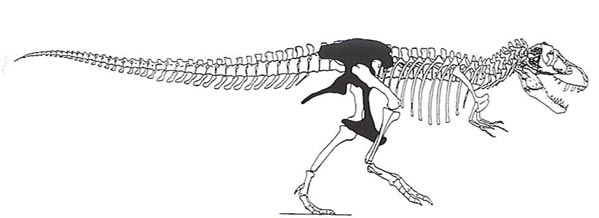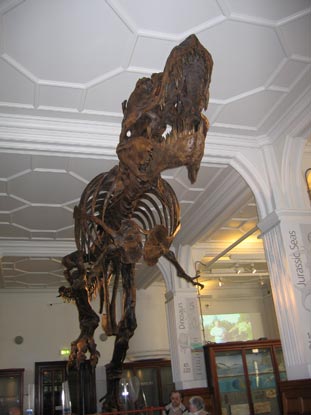T. rex and its Distant Cousin Down-Under
Evidence of Tyrannosaurid Dinosaurs in Australia
A team of scientists reporting in the academic journal “Science” have identified a fossilised hip bone dating to around 110 million years ago and claim this is evidence of Tyrannosauridae theropods in the Southern Hemisphere. Up until now, fossils of tyrannosaurs have only been found in the Northern Hemisphere.
The single bone, a sort of “smoking gun” indicating the presence of tyrannosaurs in the Southern Hemisphere is part of the lower pelvis or hip girdle. In lizard-hipped dinosaurs (saurischian dinosaurs), such as theropods, the hip bones are forked beneath the hip socket, a very typical arrangement seen in many types of reptile today, hence the name “lizard-hipped”.
Tyrannosauridae Theropods
A single, isolated bone such as this can be very difficult to ascribe to a dinosaur family. However, this bone, a pubis, resembles the very distinctive pubis bone of the Tyrannosauroidea.
Tyrannosaurs have a pubis bone, the bone that sticks out forwards, towards the head of the animal from under hip socket (ilium bone), that is very distinctive. At the base it has a broad, foot-like shape with a characteristic “heel”, at the top the end is flattened and somewhat spatulate in shape where it rests against the ilium and the ischium.
The Distinctive Pelvis of a Tyrannosaurus (T. rex)

Picture credit: Peter Larson
The illustration shows the hip bones of a Tyrannosaurus (Tyrannosaurus rex) outlined in black, with the “foot” shaped base of the forward pointing pubis clearly visible. In the fossil bone, known as NMV P186069, the shape of the pubis with its broad “foot” indicates that this could have been the bone from a Australian tyrannosaur.
An Australian Tyrannosaur
The single fossil bone, ascribed to as yet unnamed and describe Tyrannosauroidea is a little over 30 cm long, although the shaft of the pubis is broken and a piece is missing from the bottom of the bone (near the “boot” on the left of the pictures supplied). This fossil was found at the famous Dinosaur Cove site in Victoria State, Australia. Husband and wife team Tom and Pat Vickers-Rich have been responsible for the discovery of several new species of vertebrates from this particular location, although dinosaur and especially theropod remains are rare.
The Australian team combined their expertise with palaeontologists from the Department of Earth Sciences at Cambridge University and the Natural History Museum (London) and together they have produced data that could indicate the presence of the ancestors of Tyrannosaurus rex living in the southern hemisphere.
Dr Roger Benson, of Cambridge University stated:
“Although we only have one bone, it shows that 110 million years ago small tyrannosaurs like ours might have been found worldwide. This find has major significance for our knowledge of how this group of dinosaurs evolved.”
Co-author of the scientific paper, Dr Paul Barrett (Natural History Museum), commented:
“The absence of tyrannosauroids from the southern continents was becoming more and more anomalous as representatives of other ‘northern’ dinosaur groups started to show up in the south. This find shows that tyrannosauroids were able to reach these areas early in their evolutionary history and also hints at the possibility that others remain to be discovered in Africa, South America and India.”
If this is bone does belong to a 110 million-year-old tyrannosaur then it would have been a formidable predator of the regions polar forest, although it would probably have been very much lighter built than T. rex and only about 25% as big.
Did Tyrannosauroids Roam Australia?
Picture credit: Everything Dinosaur
The intriguing question that arises is why did the Tyrannosauroidea only develop into giant forms in the northern latitudes? Or perhaps the tyrannosaur fossil record is so incomplete, that there are many large tyrannosaur fossils awaiting discovery in as yet, not fully explored Cretaceous deposits of Africa, India and South America.
To replicas and scale models of various tyrannosauroid dinosaurs: CollectA Deluxe Prehistoric Life Models.


